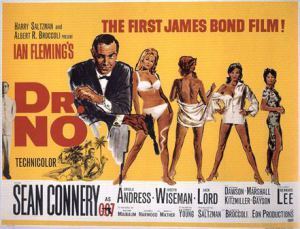John R. Phythyon Jr.'s Blog, page 7
May 4, 2015
Happy Star Wars Day: “Rocketed to Earth” on Sale
May the Fourth Be With You!
It’s Star Wars Day, when geeks, nerds, and casual fans the world over celebrate the greatest space fantasy of all time . . . and maybe even the rotten sequels and prequels.
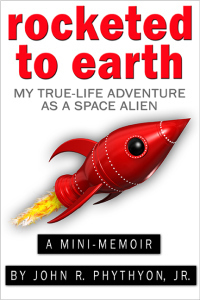 I’m celebrating in style today, with the release of my latest mini-memoir, “Rocketed to Earth: My True-Life Adventure as a Space Alien”!
I’m celebrating in style today, with the release of my latest mini-memoir, “Rocketed to Earth: My True-Life Adventure as a Space Alien”!
I was nine years old when Star Wars opened in 1977. When I saw it, my life changed forever. Science fiction in general and Star Wars in particular became my ultimate obsession for the rest of my childhood. It was virtually all I could think about.
After all, how often do you discover you’re an alien prince from another planet?
“Rocketed to Earth” is the perfect treat for Star Wars Day. It’s only a buck, it’s steeped in Star Wars trivia and the resultant pop culture of the time, and it’ll make you laugh, comforting you with the fact that someone else was geekier than you!
Click here to get it from Amazon.com for your Kindle, and May the Fourth Be With You!
Filed under: e-Publishing, Memoir Tagged: John Phythyon, memoirs, Rocketed to Earth, Star Wars, Star Wars Day


April 30, 2015
Re-Viewing James Bond: From Russia with Love
Continuing my series on the EON Pictures James Bond films, I examine the second entry in the series, From Russia with Love. As a reminder, since I’m analyzing the film both in relation to its period and how well it stands up today, this essay contains spoilers.
The Plot
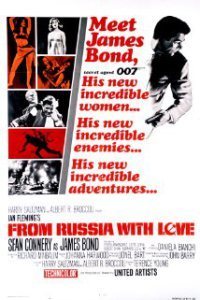 In 1963, the Cold War was at its hottest. Any edge the West could gain over the Soviets (and vice versa) absolutely had to be explored. So when MI6 is tempted with a Soviet Lektor decoder machine, they have to bite.
In 1963, the Cold War was at its hottest. Any edge the West could gain over the Soviets (and vice versa) absolutely had to be explored. So when MI6 is tempted with a Soviet Lektor decoder machine, they have to bite.
Gorgeous Russian cypher clerk, Tatiana Romanova, contacts the British consulate and says she is willing to defect and turn over a Lektor if the agent who helps her is James Bond. Allegedly, she has fallen in love with him from a file photo.
In reality, it’s an elaborate plot by the sinister criminal organization, S.P.E.C.T.R.E. The U.S.S.R.’s head of Smersh (the assassination arm of the KGB), Rosa Klebb, has defected to S.P.E.C.T.R.E., and it is she who sends Romanova on her mission, telling her it is a plot to disinform British Intelligence.
S.P.E.C.T.R.E. intends to have Romanova help Bond steal the Lektor, kill them both, and then sell the Lektor back to the Russians, making a tidy profit in the process.
Moreover, Romanova will seduce Bond, S.P.E.C.T.R.E. agents will film them in bed, and then, after they are dead, make it look like a murder-suicide, wherein Romanova threatened to go to the press with the film. All this is revenge against Bond for killing Dr. No in the previous film and foiling his plan to topple U.S. rockets.
Naturally, the evil plan goes awry when Romanova legitimately falls in love with Bond and when he proves too much for the killers S.P.E.C.T.R.E. sends after him.
The Feel
It’s impossible to examine the second James Bond movie without comparing it to the first. Dr. No is a compact film that takes place almost entirely in Jamaica. From Russia with Love is a sprawling adventure story with locations in Istanbul, a gypsy camp, Venice, and a deadly train ride that invokes Agatha Christie’s Murder on the Orient Express.
Dr. No has a mysterious villain we know little about and don’t see until nearly the end of the movie. In From Russia with Love, we meet almost all the bad guys before Bond even steps in front of the camera for the first time. Moreover, Dr. No is a mystery, wherein we’re trying to guess what’s happening. From Russia with Love tells us what the villains are up to right away.
There’s another major difference between the two movies that will impact how the series develops. Dr. No is pretty grounded. The film is exotic — from its Caribbean location to Bond’s sexual promiscuity — but it is more or less a realistic detective story.
From Russia with Love moves the series into the realm of fantasy. It is the first movie to feature gadgets. Bond’s briefcase has secret throwing knives and an exploding tear gas cartridge. Red Grant kills by garroting his victims with a wire concealed in his wrist watch. Rosa Klebb has a poisoned knife in the toe of her shoe.
Other fantasy elements infuse the movie with a sense of wonder. Bond visits a gypsy camp, and a huge fight breaks out when rival Bulgars attack, trying to kill 007’s ally, Kerim Bey. The minor villain, Krilenko, is shot trying to escape through a secret hatch in his apartment building. A boat chase through the Mediterranean Sea results in lots of explosions.
And the whole plot is over the top. Fearing Russian reactions if they adapted Fleming’s novel exactly, the producers altered the story to make S.P.E.C.T.R.E. the villain instead of Smersh, like in the book. Thus, the whole thing takes on a more fantastic feeling. It is a Cold War thriller, but by changing the bad guys from the Soviets to S.P.E.C.T.R.E., it’s not gruesome.
Where It Fits
It’s strange to label only the second movie in a series as long as James Bond as a transitional film, but that’s what From Russia with Love is. It stands as a bridge between the mostly serious spy film that is Dr. No and the all-out fantasy of the next chapter, Goldfinger.
FRWL has a strong Cold War espionage flavor. Bond is in Istanbul, and the Russians are watching everything he does very carefully. Indeed, the goal of the mission is to steal important spyware from the Soviets.
Red Grant is a heartless killer. He’s almost completely dispassionate. Bond does manage to goad him into losing his temper once. But even that is controlled. Grant otherwise displays no emotion as he kills victim after victim to ensure Bond gets out of Istanbul with Romanova and the Lektor.
But there’s also a lot of outrageous material that will come to be hallmarks of the series. In addition to the aforementioned gadgets and the credulity-stretching plot, the characters become larger than life to complement Bond.
Kerim Bey has a broad personality, and he steals every scene he’s in. Funny, likeable, and capable, Kerim is the perfect ally for the suave, British spy.
From Russia with Love has multiple villains. It is the first movie to feature a privileged henchman — the superhuman killer Bond must defeat before he can take out the mastermind — in Red Grant. And then there is Klebb, who is running the operation for S.P.E.C.T.R.E., and chess master Kronsteen, who conceives the plot and plans out all the details. Both of them, though, are lackeys themselves in the employ of the mysterious, unseen head of S.P.E.C.T.R.E., who, despite being named as Ernst Blofeld in the closing credits, is referred to only as “Number One.”
The fact that From Russia with Love is a hybrid between the first Bond picture and the ones that follow it makes it my favorite film in the series. It has all the intrigue of a spy thriller with enough fantasy to make it a lot of fun.
More than 50 years after its release, From Russia with Love holds up well. The politics woven through the film are long gone, but the story is complex enough without being obtuse that it plays very well, even as a period piece.
Filed under: James Bond Tagged: From Russia with Love, James Bond, John Phythyon


April 27, 2015
Making Fantasy Reality: THE SWORD AND THE SORCERER and Marriage Equality
As you’ve probably heard if you pay attention to the news or spend a lot of time on Facebook, the Supreme Court is taking on the question of gay marriage on Tuesday.
The case stems from a suit in the 6th Circuit Court of Appeals, which coincidentally happens to be in my home state. A gay couple was married in Maryland and returned to Ohio. A year later one of them died, and his husband wanted his name listed on the death certificate as spouse. Ohio doesn’t recognize gay marriage, so there’s been a protracted legal battle over it that has finally landed the question in the Supreme Court. The outcome may result in overturning the remaining state bans on same-sex marriage (including Ohio’s) and making it legal nationwide.
I’m a happily married straight man. I’ve got three kids who all (as far as I know) are straight.
And I’m hoping SCOTUS will find in favor of the plaintiffs so that marriage equality is the law of the land from henceforth.
In my view, it’s a very simple civil rights issue. LGBTQ+ couples want to wed. The state conveys certain privileges and advantages (tax and estate) to married couples. Therefore, it’s discriminatory to deny some citizens access to those benefits.
So I’ve been campaigning in my personal life among friends and associates for support of the issue of gay marriage. I’ve made myself an ally wherever possible and encouraged my children to do the same.
I believe in the old saw of “put your money where your mouth is,” so I also have been donating to Freedom to Marry — a national organization that has been battling for marriage equality. Since publishing my novel, The Sword and the Sorcerer in December of 2013, I’ve been donating a dollar from every sale of the book to Freedom to Marry.

Sales from THE SWORD AND THE SORCERER benefit Freedom to Marry.
The Sword and the Sorcerer features a gay couple. It’s set in a fantasy world with wizards and dragons, but the protagonist is gay, and his boyfriend is a soldier turned courtier. The two are drawn into a quest involving the murder of the world’s most powerful sorcerer (the protag’s father) and the struggle to reset the balance of power in the world that ensues.
It’s not the sort of thing one might think of as “gay literature.”
But among the things I wanted to accomplish with this novel is to imagine a world where the sexual orientation of the main character is of no consequence, even if he’s homosexual. Throughout the story, everyone knows Calibot and Devon are gay and involved. That never matters to anyone. It’s just accepted as fact.
When the bad guys try to kill them, it’s because the couple threatens the evil scheme. When they acquire allies, it’s because people think they are in the right.
But no one stops to wonder why two men are in a romantic relationship.
Indeed, the duke they serve values them both for what they bring to his court. He wants Calibot for his skill as a poet and Devon for his military wisdom.
The Sword and the Sorcerer isn’t really about gay marriage. It just has a long-term, same-sex relationship that is central to the lives of the main characters, and everyone sees it as normal.
So to help create that sort of reality here in the U.S., I’ve been donating a portion of my sales to Freedom to Marry. This week, I’ve put the book on sale for 99 cents. I’ll still donate a dollar per sale, so I’m basically giving it away for free in exchange for a one-dollar donation to Freedom to Marry.
I invite you to help me make fantasy a reality for LGBTQ+ couples. Click on the link below to get a copy of The Sword and the Sorcerer. You’ll get a 4.5-star fantasy novel and help Freedom to Marry win the fight to secure marriage rights for all Americans.
Click here to purchase The Sword and the Sorcerer from Amazon.com.
Filed under: Current Events, The Sword and the Sorcerer, Why I Write Fantasy Literature Tagged: Freedom to Marry, Gay marriage, Supreme Court, The Sword and the Sorcerer


April 23, 2015
MAGIC & MONSTERS Available
I’m very pleased to announce I have a new book available. Magic & Monsters is a collection of five short stories from various points in my publishing career, including a brand-new piece written just for this volume.
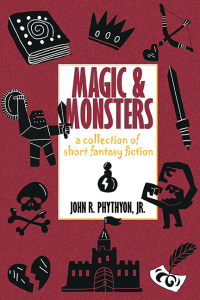 As the title suggests, the theme of the book is the monsters that walk among us. Sometimes, they are traditional creatures of the night, such as the vampire that haunts the protagonist of “Closet Fears.”
As the title suggests, the theme of the book is the monsters that walk among us. Sometimes, they are traditional creatures of the night, such as the vampire that haunts the protagonist of “Closet Fears.”
But more often, the real monster in the story is a person, and it isn’t always obvious at the outset of these tales whom the real fiend is.
Two of them are set in contemporary America, the other three in fantasy kingdoms. But they all feature a character who must use magic to confront an insidious beast.
Click here to get it for your Kindle from Amazon.com.
Here’s the blurb:
Evil wears many faces. . . .
A man���s wife returns from the dead to take revenge on him for betraying her.
A princess makes a disturbing decision when she turns her suitor into a frog and then can���t undo it.
A witch fights oppression from a bigoted king.
Her grandmother���s heirloom may prove the perfect solution to a distraught wife with a cheating husband.
A kung fu warrior faces the vile princess who stole her love.
Five short tales of betrayal, revenge, and sorcery fill this collection from John R. Phythyon, Jr. Each features magic and a monster whose identity isn���t always clear at the beginning of the story. Each poses questions about what is right and what is justified.
Fantasy and horror merge in this cross-genre collection in which Phythyon explores the monsters walking among us and the magic we use to confront them.
Includes the Origins Award-nominated story, ���Xing Qing Pao���s Lament.���
Click here to get it from Amazon.com.
Filed under: Magic & Monsters Tagged: fantasy fiction, John Phythyon, Magic and Monsters, short stories


April 20, 2015
Re-Viewing James Bond: Dr. No
With a new James Bond movie coming out in November (and a new Wolf Dasher novel at the same time), I thought I would take the opportunity to re-watch every one of the EON Pictures films and discuss them in terms of where they fit into the Bond mythos, what they reveal about the time period in which they were made, and how they stand up to today’s scrutiny.
I plan to take them in order, so I’ll be starting today with 1962’s Dr. No.
(Note that, since I am dissecting the films, there are spoilers in the blog.)
In 1962, the Space Race was in full flower, John Kennedy was in the White House and dealing with The Cuban Missile Crisis, and atomic power was both poorly understand by the general public and seen as the way of the future.
With this backdrop, we meet James Bond, Agent 007 of Her Majesty’s Secret Service. Bond is assigned to travel to Kingston, Jamaica, and investigate who killed MI6’s man there, Peter Strangways.
As it turns out, Strangways was looking into someone mysteriously toppling U.S. rockets using radio waves. The trail leads to a small island called Crab Key and a sinister Chinese scientist named Dr. No. No is working for S.P.E.C.T.R.E., an international criminal cartel worse than the Casa Nostra and crueler than the Soviet KGB. He kills anyone who gets in his way, including Strangways, and he makes several attempts on Bond’s life before 007 is finally captured and brought before him.
The U.S. is planning a moonshot rocket to orbit the lunar body and send back scientific information. Bond has to find Dr. No and stop him before the rocket lifts off. It’s a classic Cold War plot with the only twist being the villain working for an independent criminal organization instead of the Russians.
The Feel
The first thing you notice about Dr. No is its languid pace. If you’ve seen a James Bond picture in the past twenty years, you know there are lots of explosions, killings, and car chases.
But the first film in the series is a lot softer. There is a lot of killing in Dr. No, but much of it happens off-camera. Bond cuts the throat of a S.P.E.C.T.R.E. crony, but all we see is Honey Ryder gasping in horror. Strangways and his secretary are gunned down in cold blood, but we only see it briefly. Quarrel is burned to death with a flamethrower, but all we see is a look of terror on his face, then a long shot of the fire and a scream.
Likewise, the film’s one car chase is accomplished mostly with bluescreen effects. We see little of the cars racing through the mountains, driven daringly by stunt drivers. It’s not altogether obvious what causes the pursuer to careen out of control and crash down the side of the mountain, because we don’t see it happen.
Moreover, the format of the film is much less a thriller/action movie than it is a detective story. Bond spends a lot of his time in Dr. No investigating clues. He walks around. He asks questions. He snoops.
But he doesn’t do a lot of fighting. By today’s standards of action adventure, Dr. No is pretty tame.
But the movie is violent. In 1962, Bond’s actions were eye-opening. He kills Professor Dent dispassionately, shooting him twice without changing expression. When he slits the throat of the goon searching for them on Crab Key and Honey asks, “Why?”, he replies simply, “Because I had to.” Aside from the beginning of the movie, when he is still in London, Bond is neither suave nor debonair. He’s blunt and almost thuggish in his approach to bringing Strangways’s killer to justice.
Bond is shocking in another way that seems tame today. Over the course of the movie, he has sex with three different women. One of them he knows to be an accomplice of Dr. No, and he’s just taking what he wants from her while he waits for the police to arrive.
The sexual revolution was budding in ’62, but a hero who sleeps with three different women was not the kind of person movie audiences were accustomed to seeing. In particular, Eunice Gayson’s Sylvia Trench is brazenly provocative, throwing herself at Bond before he can leave the country for Jamaica.
While there remains a degree of slut-shaming in today’s culture, fifty-three years before, a women like Sylvia Trench (who has sex with Bond just because she thinks he’s hot) and the government house secretary (who allows Bond to bed her twice to keep him at her home long enough for an assassin to show up and kill him) were shocking.
Where It Fits
Dr. No is a time capsule to another age. The titular villain uses atomic power, and a lot of time is spent detailing the potential effects of radiation — which was the #1 nightmare in the post-atomic era. B-movie monster films like Them! and Marvel Comics superheroes posited the strange, unknown effects of radiation on the natural environment. Indeed, Dr. No has lost his hands due to radiation poisoning and uses metal prosthetics.
While its role in the film is subtle, atomic power is key to the whole story. Bond is led to Crab Key by residual radiation on rock samples Strangways brought back. To stop Dr. No from toppling the U.S. rocket, Bond creates a nuclear accident, overheating the reactor core which destroys not only the toppling system but the entire base. Nearly two decades before Three Mile Island and three before Chernobyl, the deadly nature of losing control of nuclear power is shown.
Dr. No also casts an historical eye on the Space Race. In 2015, launching a rocket into space to see what is out there is, at best, passe. I watched the movie with my 14-year-old, and I had to explain to him that, at the time the film was made, we had not yet put a man on the moon. So little was known about space then, and the U.S. and Soviet Union were in a desperate race to be the first not only to learn what was possible, but also to turn it to military advantage.
My stepson remarked how heavy the rocket was when the announcer on the broadcast Dr. No is monitoring reports it is 240 tons. I said, “Yeah, and they’re going to shoot it into space.”
“Good luck with that,” he replied, his tone stating clearly he didn’t think such a thing was possible.
I smiled, knowing that it was possible, that it had been done. There was a clear generation gap between us — he born into an age where science was not thought to be wondrous and capable of accomplishing anything. He did not grow up watching rocket launches from Cape Canaveral, did not stand in awe at the development of the space shuttle.
Dr. No takes us back to a time when less was known, but more was believed about the potential of human achievement.
As Bond films go, Dr. No is pretty atypical. It is the least exciting entry in the series. With minimal fights, only two explosions, a single chase that is largely filmed in a studio, and a detective-story format, it is not by any means an edge-of-your-seat thrill ride. But it is an intense espionage movie that recalls the unknowns of space exploration and the quiet terror of the Cold War. Thoughtful, clever, and, for its time, shocking, Dr. No is a classic that holds up well on repeated viewing.
Filed under: James Bond Tagged: Cold War, Dr No., James Bond, Space Race


April 13, 2015
The Return of SSR
When I was in elementary and high school, they used to make us read. In an era before well funded fights over defunding education and teaching students to pass standardized tests to qualify for government assistance, our administrators felt taking time out of the day to encourage reading was a good idea.
 Twenty minutes a day, we would stop all other learning for Silent, Sustained Reading, or SSR as it was commonly known. At such times, you had to take out a book and read quietly for the duration of the period. It couldn’t be a schoolbook. It had to be something — usually fiction, but not restricted to that — that you picked out and were ostensibly reading for pleasure, despite the fact that this was a forced activity.
Twenty minutes a day, we would stop all other learning for Silent, Sustained Reading, or SSR as it was commonly known. At such times, you had to take out a book and read quietly for the duration of the period. It couldn’t be a schoolbook. It had to be something — usually fiction, but not restricted to that — that you picked out and were ostensibly reading for pleasure, despite the fact that this was a forced activity.
The theory was, teaching people to love reading was a good idea, and the best way to do that was to require it for 20 minutes a day, five days a week. There was no homework assigned from this “class,” but as we matured into middle-grade readers, we were required to do book reports, so SSR was an excellent opportunity to get the work for that in.
Being the teacher’s pet that I was (as well as a kid who found exciting adventure stories more interesting than math problems), I loved SSR. It was 20 minutes a day where I got to read! That was almost as good as recess.
Moreover, I could devour science fiction and fantasy novels, and it was treated as something I was supposed to be doing. SSR was way to the good in my young opinion.
I’m an adult now, and things have changed. As an entrepreneur, I have an insanely busy schedule of writing and editing my own books, marketing them, managing sales, and overseeing the short- and long-term strategy of my publication schedule.
I’m also a parent of teenagers, whose schedules I have to manage and make sure everyone is getting where he or she is supposed to be on time on the correct day with whatever it is he or she needs. I also prepare dinner for the family and generally run the household.
Reading has taken a backseat to all those concerns.
Moreover, what little reading time I have, I usually spend reading my own books. That’s not because I’m a narcissist. Rather, it’s because you can’t just write a book and put it out into the world. It requires a lot of shaping and crafting, and the only way to find the parts that suck and fix them is to read it — usually multiple times.
But you know what piece of advice I hear constantly about how to be a good writer? Read.
By which they mean, read other people’s books.
And I’m down with this idea. I don’t like reading any less than I did as a kid. In fact, I really enjoy it on my Kindle. I can instantly look up words I don’t know, I never lose my place, and I can update my progress in a book on GoodReads at the end of each session. Plus, the advent of digital publishing has put an even larger wealth of reading material at my fingertips for less than it would cost me to buy a book at the store.
But it still requires time. You still have to actually make some time to sit down and read.
So I’ve revived SSR. Every day, I block out at least 30 minutes to read. I make a to-do list every morning, to map out my day, and I now consciously put SSR on it, so I remember to make the effort.
And it’s working. I’d been reading a novel I quite liked, but it I’d only cracked about 10% of it after several weeks of calling it up on my phone and reading a few pages while waiting on something else — like my daughter to get out of school.
Since I instituted SSR a week ago, I’m 94% done. I have other books on my Kindle I can’t wait to get to, and I’ve agreed to beta-read a sci-fi novel for a colleague. I’d never have done that two weeks ago. I just didn’t have time.
But now I do, because I make it. Like my teachers when I was in school, I recognize the value of taking time out of my day and reading for pleasure. It’s relaxing, it’s fun, and it’s positively impacting my work. I find my mind racing on my own novels, because the book I’m reading now is inspiring me.
Before we decided to fight over Common Core and school vouchers, our educational system was teaching the simple joy of reading and, more importantly, that you needed to make time for it on a daily basis.
I am glad I finally remembered that lesson. I hope not to forget it again.
Filed under: Uncategorized Tagged: books, Kindle, reading


April 2, 2015
Why Clean Reader is Offensive
Occasionally, I feel obligated to take on a major issue in this space. It’s not really what I like to use my blog for, but I’m a human being living in the world, so I have a responsibility to speak up when something is troubling me.
There’s an app out there that lets you alter the content of the eBooks you read. It’s called Clean Reader. It was created by Idaho parents whose daughter read a book at school that she said made her uncomfortable because it had swear words in it. When the parents discovered there was no app on the market that allowed them to sanitize books, they saw a need and filled it.
Clean Reader has several settings (including “off”), which enable you to scour away words you might find offensive. The higher the setting, the stricter it is about what it allows you to read. At its highest, it will remove certain uncomfortable racial epithets and even the least offensive words, often substituting others for them (e.g., “darn” for “damn”).
You can read an article on Clean Reader and how it works here (I refuse to link to their official site). Chocolat author Joanne Harris blogs about Clean Reader here (which includes an email she received from them and her response). And author/blogger Chuck Wendig takes on the issue here. (Warning: Wendig is famously and gloriously profane, so you can imagine how profanity-laced his response is.)
I’ll let Harris take up the mantle of this being a slippery slope to book burning and witch hunts. I’ll allow Wendig to make the point with creative cursing of respecting artistic choice.
I want to take this on from the point of view of a guy who keeps the swear words in his books to a minimum.
The argument for removing profanity from books (or movies or TV shows, for that matter) is that it’s lazy writing. Instead of thinking of a creative way to say something, the author just throws in a swear word.
Maybe there are writers who do that. I don’t know any, nor have I ever heard of (or read) one.
If you think authors don’t agonize over word choice, you don’t know anything about writing. We all think carefully about our words. We recognize their power, and we understand that we are manipulating language to draw a picture a particular way. Just as an artist chooses colors, we choose words. Just as Picasso deliberately painted differently than Monet, we pick the words peculiar to our vision of the story.
I very deliberately limit the amount of profanity in my books. I think curse words read more starkly than they sound. I believe they are more jarring in print than spoken.
So every time a situation might call for swearing, I decide if I need it there. And if the answer is yes, I think very carefully about which curse word is appropriate. The word, “damn,” for example, has always been the bottom rung of naughty words for me, but I am sensitive to the fact that, for some Christians, it is far more offensive than say, “shit.”
So I think about it. What’s the right word for this situation? How strong should the language be? If this is dialogue (and it usually is), would the character use one word over another? Why?
Here’s an example from my most recent novel, Little Red Riding Hoodie: A Modern Fairy Tale. The book’s principal villain is a 12-year-old Mean Girl named Molly Richards. She tries to seduce the protagonist’s would-be boyfriend, Brian, to sit at her table at lunch instead of at the main character’s. When he refuses, she calls him a faggot.
I spent a lot of time thinking about whether I wanted to do that. I wasn’t sure I wanted to have him bullied as homosexual, and I wasn’t certain I should use a word as hateful as “faggot.” It’s jarring, and it’s the most offensive thing that happens up to that point in the narrative. Molly goes to a whole new level with that insult.
In the end, I decided it was important to do it. It establishes Molly not only as mean and as a bully but also as a bigot. She is willing to say anything to hurt people. By having her call Brian a faggot, we see Molly clearly for whom she is.
Brian’s response is immediate and strong. He’s black, and he retorts by asking why Molly doesn’t just drop an N-bomb on him.
Again, I had to think very hard about what to do here. Should I have Brian actually use the N-word instead of a more sanitized code phrase? If he was offended (and he is), wouldn’t he push the envelope further? And because he’s black, doesn’t he have the cultural authority to say it?
Ultimately, I decided not to have him use that word. I decided he found it so offensive, he wouldn’t say it. And that reveals something about his character. Brian has no tolerance for bigotry of any sort.
If Clean Reader scrubs “faggot” out of my novel, the entire context and meaning of that scene is lost. Our understanding of the characters and the situation isn’t the same.
And I’m sorry, Clean Reader, but you don’t get to make that call. I’m the artist. I made a choice. I did it for a very specific reason, and you don’t get to take that away from me so that “more people will want to read my book.”
Because if you can take out a word you don’t like, it’s a short step to taking away a theme you don’t like. Brian later explains that he’s an ally — that a gay person can’t be any less gay than he can be less black.
Will that be offensive to some readers? Should they have the right to remove that scene because thinking about a black kid supporting gay rights makes them uncomfortable?
I don’t just write adventure stories with magic and monsters. I write about racism and religious extremism and bullying and overprotective parents and alcoholism and other uncomfortable subjects.
And I do that very deliberately.
That’s the thing about art. It doesn’t exist solely to entertain or make you feel good. It pushes the envelope of acceptable behavior. It explores the depths of the human condition. It shines a light on the beautiful and the ugly.
And the consumer doesn’t get to tell the artist how he or she expresses his or her art.
You can disapprove. You can condemn. You can refuse to read it (or look at it or watch it).
But you don’t get to say, “You can’t do that.”
That’s censorship. That’s wrong.
Young people who read Little Red Riding Hoodie should feel uncomfortable when they read the word, “faggot.” They should understand that it is hateful and cruel. They should see that Molly is someone to be reviled, that her behavior is absolutely unacceptable. That’s my point as an author. I made an artistic choice to reinforce my theme.
And it wasn’t lazy writing. If Molly had said, “Sorry, I didn’t realize you were gay,” it would not have had nearly the impact of her saying, “Sorry, I didn’t realize you were a faggot.”
Authors choose their words carefully. They are artistic decisions designed to craft a very specific picture.
And neither Clean Reader nor anyone else gets to make substitutions because they object to particular expressions.
If my words make you uncomfortable, chances are I’m doing something right.
Filed under: Current Events, Writing, Writing Villains Tagged: censorship, Clean Reader, writing

March 31, 2015
“Swing and a Miss” On Sale!
I’m pleased to announce my fourth mini-memoir, “Swing and a Miss: My True-Life Adventure in Baseball” is now available for sale at Amazon.com (get it here).
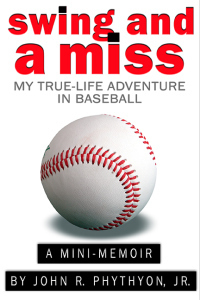 Once again, I’m traveling back in time to the 1970’s — when The Big Red Machine was winning World Series, when my father taught my brother Dave and I the religion of baseball, and when dreams of hitting an heroic ninth-inning, walk-off homerun were easy to believe could happen.
Once again, I’m traveling back in time to the 1970’s — when The Big Red Machine was winning World Series, when my father taught my brother Dave and I the religion of baseball, and when dreams of hitting an heroic ninth-inning, walk-off homerun were easy to believe could happen.
Unfortunately, what I would learn over a six-year career in youth baseball, is that America’s pastime is a sinister game that tricks you into thinking it’s easy. I spent my formative years battling the game — loving it with all my heart while enduring disappointment after disappointment on the ball diamond.
Like the other mini-memoirs, this one is satirical. I examine being afraid of the ball, struggling to hit a pitch, and dying for my chance to win a big game for my team the way Carlton Fisk did in Game 6 of the 1975 World Series.
This book is love letter — both to baseball and to my father and his tutelage. Of the four of these, “Swing and a Miss” is easily the most sentimental.
Like the others, it’s only 99 cents, so you can get a child’s-eye view of 1970’s baseball for only a buck! Click on the link below to get it for your Kindle-enabled device.
Click here to purchase “Swing and a Miss: My True-Life Adventure in Baseball” from Amazon.com.
Filed under: Memoir, Writing Tagged: baseball, humor, John Phythyon, memoirs

March 11, 2015
Why I Love my Editor
I love my editor.
Perhaps it sounds trite, but she makes me so much better. Without her, I’d be a mediocre writer.
Back when I was in college, I had this naive and arrogant idea that writing was this singular, artistic process. When you sat down and starting typing, a magical, creative event was occurring. The art was the exact choice of words at that particular moment in time. One shouldn’t alter too much — just correct typos — because to do otherwise was to mar the art.
What can I say? I was young and stupid. I was also pretty full of myself. My only explanation is that I was in my early 20’s.
The truth is the artistic part of writing doesn’t happen in the first draft. That initial part of the process — the actual writing, if you will — is more akin to manufacturing. You’re building the raw materials.
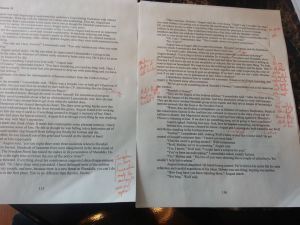 The art is in the editing, the rewriting. This is where raw words get shaped to become something beautiful. This is where a simple writer becomes an author, a craftsman.
The art is in the editing, the rewriting. This is where raw words get shaped to become something beautiful. This is where a simple writer becomes an author, a craftsman.
I got the second draft (I never let anyone read a first draft) of the next mini-memoir, “Swing and a Miss: My True-Life Adventure in Baseball,” back from my editor.
“It’s good,” she said. “But it’s missing something. Your first three were about you. This one’s about baseball. You need to make it more like the first three.”
That crushed me. First, I’d thought the manuscript was pretty good. Second, I’m running a pretty tight ship this year. While I have built in plenty of lead time for each project, I thought I was ahead on this one. I thought I had time to worry about other books. I didn’t really want to have to take this one back to R&D.
I could have ignored her. She’d have accepted me writing a love letter to baseball instead of to my childhood like I had with the other three.
But I remember the words of one of my choir directors in college: “Don’t ever put your name on crap.”
As written, it wouldn’t have been crap, per se. But it would have been less than I am capable of, and that’s outside my work and artistic parameters.
So I dug into it. And of course, she was right. Between stress and a busy schedule, I’d been phoning it in. The book was based largely on an earlier manuscript, and I’d basically just punched up four-year-old text to be a little better.
But it wasn’t what I was capable of.
So I edited the daylights out of it. I looked for opportunities not only to change the focus from baseball to my childhood adventures but to really tell a good story. The original MS was half-assed. It was a good beginning, but it was not worthy of being published in its current state.
As my pen flew furiously, making suggestions and pointing out instances where I had lazily told the story instead of shown it, I felt my mind opening up. I felt myself coming alive again. The stress of the previous weeks melted away. I took joy in the craft of the rewrite.
It’s already a much-better book, and I’m only half done. I had hoped to be further along in the process this week, but I don’t care. I am writing a good book instead of a mediocre one.
I love my editor. She makes me so much better.
Filed under: Memoir, Writing Tagged: editing, John Phythyon, writing

March 5, 2015
Inspirations: STAR TREK II
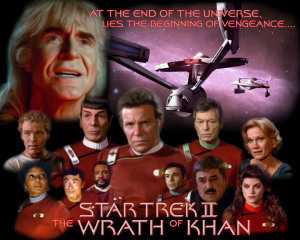 With the passing of Leonard Nimoy last week, it seemed like a good time to discuss one of my all-time favorite films and its influence on me as a writer.
With the passing of Leonard Nimoy last week, it seemed like a good time to discuss one of my all-time favorite films and its influence on me as a writer.
In fact, Star Trek II: The Wrath of Khan might just be my favorite movie ever.
It is a perfect film in so many ways. Most importantly, it taught me so much about storytelling, including the idea that action-adventure yarns can (and possibly should) have deep, human themes.
Thematic Complexity
There is a lot going on in Star Trek II. When the film opens, Jim Kirk, now an admiral, is in a malaise. Because he was promoted, he is no longer captain of a starship. He works on Earth, training new recruits to explore strange new worlds, instead of boldly going himself.
Kirk, so good at solving problems in a crisis, isn’t good at self-reflection. He isn’t able to see what his trouble is, but his friends point it out to him.
“Get back your command,” McCoy tells him. “Get it back . . . before you really do grow old.”
And Spock puts it more bluntly: “It was a mistake for you to accept promotion. Commanding a starship is your first, best destiny.”
But Star Trek II is about more than an iconic pop cultural figure having a mid-life crisis. The story also centers around how things we leave buried in the past have a way of catching up to us.
The film’s titular villain, Khan Noonian Singh, is a megalomaniacal genius Kirk defeated on Star Trek’s first season. Kirk marooned him, but as Khan reveals, the now-admiral never checked on them, and a cataclysm caused most of Khan’s people to die. When the crew of U.S.S. Reliant accidentally discovers him, he steals the ship and sets off on a bloody quest for revenge.
But Khan isn’t the only skeleton in Kirk’s closet. There is also Dr. Carol Marcus. The details are never revealed, but it’s obvious she and Kirk had a stormy relationship that resulted in him fathering a son before an ugly breakup. David has become a scientist like his mother, and he’s learned to hate his father.
Both Drs. Marcus are involved in an experimental life-creation project called Genesis that Khan seizes to use for genocidal purposes.
Among the film’s most poignant moments is towards the second act, when all hope looks lost. Responding to Carol’s inquiry on how he’s feeling, Kirk replies, “There’s a man out there I haven’t seen in fifteen years, who’s trying to kill me. You show me a son who’d be happy to help.”
Star Trek II is not just an action film pitting good versus evil. It is the story of a man struggling to reconcile his past with his present.
The Big Picture
Those personal themes of aging and regret over mistakes made are only a piece of what is happening in the film, though. There is a larger framework of the meaning of human life.
The film begins with trainee Lt. Saavik taking the Kobayashi Maru test — a no-win scenario designed to evaluate the character of potential captains. Like everyone who took the test before her, Saavik fails. In an attempt to rescue crew members of a disabled ship, she violates treaty and gets everyone aboard the Enterprise killed.
Saavik is understandably frustrated, and that eats at her Vulcan stoicism throughout the film. We eventually discover that, when Kirk was a cadet, he reprogrammed the simulation so he could rescue the crew. As David puts it, “He cheated.”
Kirk justifies this infraction by saying he doesn’t believe in the no-win scenario, and this sets up a debate that rages through the film coming to no satisfactory conclusion.
In a way, Kirk is right. Despite being outgunned and his ship being terribly damaged, Kirk is able to defeat Khan. But for it to be more than a Pyrrhic victory, for the crew of the Enterprise to survive, Spock, Kirk’s best friend, must sacrifice himself. Had he known what Spock would attempt, Kirk would never have allowed it.
But the choice isn’t his. Spock confronts the no-win situation and makes his choice.
“Don’t grieve, Admiral,” Spock tells him as he’s dying. “It is logical.”
And then Spock reiterates another of the film’s major themes — “the needs of the many outweigh the needs of the few or the one.” Personal desire and ambition — like Kirk’s drive for success and Khan’s lust for revenge — are destructive and don’t serve the best interests of larger society. Moreover, Spock presents Kirk with a better way forward.
“I never took the Kobayashi Maru test before now,” he says. “What do you think of my solution?”
Unlike Kirk, Spock sees the big picture. He makes a choice that preserves the most lives, does the most good.
Action!
All of these deep literary themes are deftly handled in the space of a taut thriller. Screenwriter Harve Bennett paces the story perfectly. The tension builds nicely to the first confrontation between Kirk and Khan at approximately halfway through the film.
Khan wins the initial match, and Kirk barely escapes alive. His survival comes at a terrible cost. Much of his crew — mostly young trainees — are killed or wounded by an enemy they don’t know or understand.
Khan uses Kirk to locate the Genesis project, so he can steal it — another victory for the villain. He appears to have the ultimate triumph over Kirk, seemingly marooning him just as Kirk did to him.
The final battle between the two is pulse-pounding. Director Nicholas Meyer uses the format of a submarine movie to ratchet up the tension as the two titans search for each other.
And after Kirk disables Khan’s ship, the villain isn’t done. If he’s going to die, he’s going to take his nemesis with him. He sets Genesis to go off, so Kirk’s disabled Enterprise won’t be able to get away, setting up Spock’s sacrifice.
And because Spock is one of the main characters — a giant part of the show’s ethos — his death is unthinkable. No one expects him to actually die.
A Lot of Character
Finally, the characters in Star Trek II: The Wrath of Khan are powerful. Kirk is tortured by his demons. Spock is the wise, stoic. McCoy carries the film’s conscience — arguing passionately for Kirk to regain his command and against the existence of Genesis. Saavik is the frustrated youth, unable to fully reconcile her Vulcan stoicism with her anger and disappointment in the man who is supposed to be training her.
And then there’s Khan. He is among the great villains in cinematic history. Larger than life, he is both dangerous and accomplished. He’s smarter and cleverer than Kirk. He’s ruthless and bloodthirsty. He also is devoted to his people, rewarding their loyalty.
But he is too obsessed with avenging himself on Kirk. “He tasks me,” he says quoting Moby Dick. “He tasks me, and I shall have him.”
Khan’s Ahab-like obsession with besting Kirk leads to his downfall. His advisors try to persuade him to find new worlds to conquer, but he won’t listen. In the end, that’s what destroys him.
Timing Is Everything
I was 14 years old when Star Trek II: The Wrath of Khan hit theaters. I’d been a casual fan of Star Trek, watching reruns on Saturday mornings in my childhood. My father took me to see Star Trek: The Motion Picture three years before.
But this film was so very different from any Trek I had seen before. It was bold and action-oriented, something many of the episodes and the first feature film were not. It was also primal. Star Trek II invoked the rawest emotions in me.
I saw it several times, and I watched it over and over when it came to cable. I had it practically memorized before I was 16.
I was offended when 1984’s Star Trek III: The Search for Spock undid the sacrifice and noble death of Spock. To this day, it is the only Star Trek film I refused to see in the theater.
Regardless, because I was young, “Wrath of Khan” was in position to really influence me. Youth comes with a lot of leisure time,�� and cable TV made it possible to watch a film to death. Thus, Star Trek II imprinted on me, even the parts of it I was too young to understand at the time.
But these days, as a writer in my 40’s, my heroes are Jim Kirk — tortured, struggling, perhaps even impetuous. It doesn’t matter if they are the mid-30’s Wolf Dasher, who is hyper-aware of the hypocrisies of the government for which he works and the religion of his allies, the early 20’s Calibot, hero of��The Swords and the Sorcerer, who is angry his father didn’t love him for whom he is, or 12-year-old Sally Prescott, the main character in Little Red Riding Hoodie, who must care for her brother after her mother left and her father became an alcoholic. All of them are uncomfortable in the world, and seek to find some place to belong, like an aging Kirk, lost when he’s not commanding a starship.
They are surrounded by allies who give them support, friendship, and love. May Honeyflower loves Wolf unquestionably, passionately — McCoy to Wolf’s Kirk. Likewise, Devon is in love with Calibot but gives him gentle, graceful advice like Spock. Alison stands by Sally under any circumstance, willing to follow her into Hell if need be, just as Khan’s followers do.
And my villains all have a piece of Khan in them. Sagaius Silverleaf is a megalomaniac. Elmanax is obsessed with revenge. Molly Richards is larger than life.
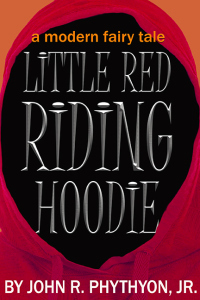 I may write adventure stories, but they are not simple battles of good versus evil. Wolf Dasher battles more than James Bond-style masterminds. He fights against blind nationalism, struggles with the impact of religious extremism, and questions the motivations of his own government.
I may write adventure stories, but they are not simple battles of good versus evil. Wolf Dasher battles more than James Bond-style masterminds. He fights against blind nationalism, struggles with the impact of religious extremism, and questions the motivations of his own government.
Calibot is a young man trying to come to terms with a father who never loved him while grieving over his death. How can he reconcile love and loathing?
Sally battles depression and bullies. She desperately wants to succeed in the school play, but she is beset by the kinds of troubles a sixth-grader shouldn’t have to face, although many do.
And I write this kind of literature because Star Trek II: The Wrath of Khan showed me how. High-minded literary fiction and thrilling action-adventure can co-exist in the same story.
For all those reasons and maybe a few more, Star Trek II: The Wrath of Khan may just be my all-time favorite film. It is also one of the most profound influences on my work as an author.
Filed under: Inspirations, Little Red Riding Hoodie, State of Grace, The Sword and the Sorcerer, Writing Tagged: Captain Kirk, Khan, Leonard Nimoy, Spock, Star Trek II


